Financial Reporting: Analysis, Standards, and Stakeholders
VerifiedAdded on 2021/02/19

REPORTING
Paraphrase This Document
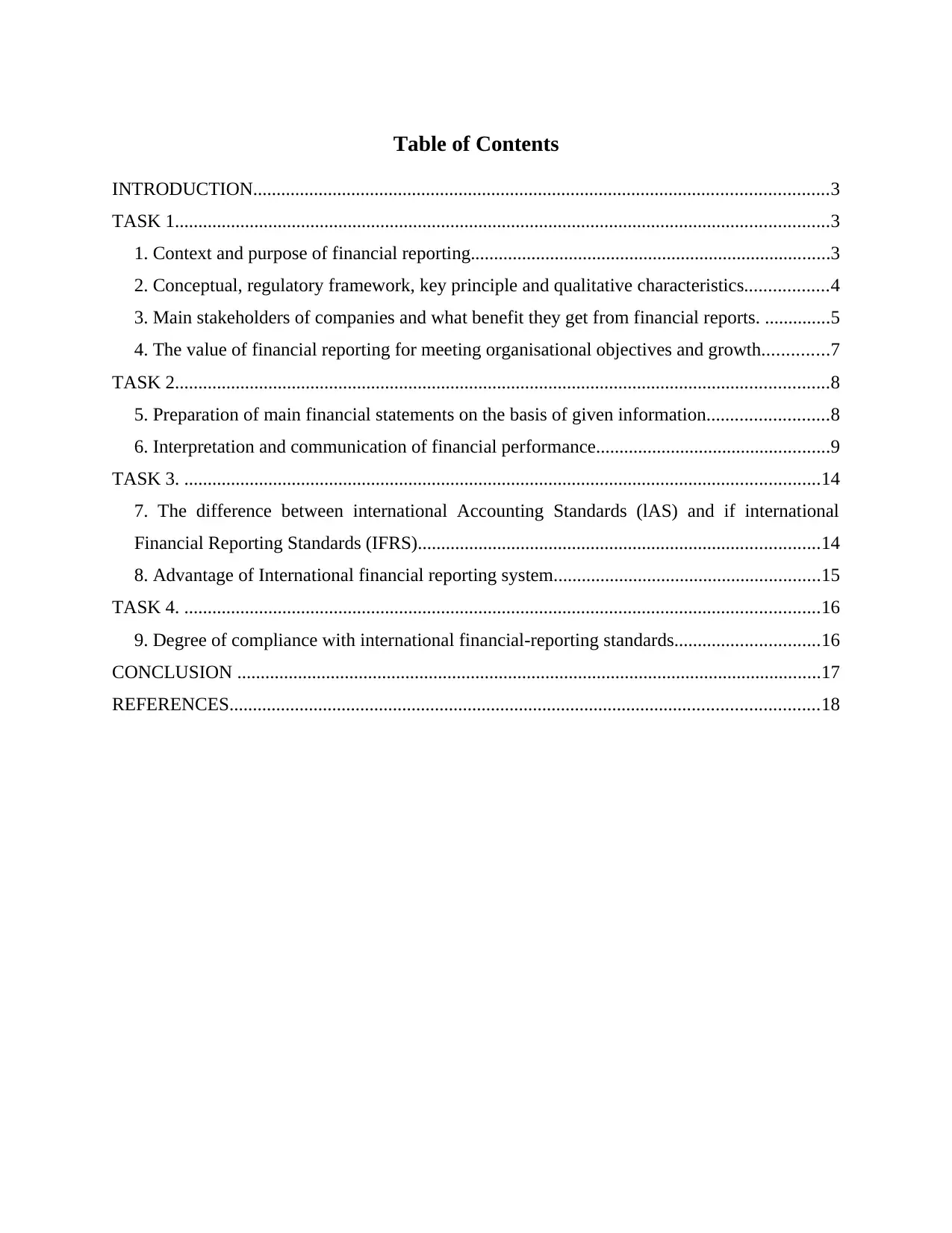
INTRODUCTION...........................................................................................................................3
TASK 1............................................................................................................................................3
1. Context and purpose of financial reporting.............................................................................3
2. Conceptual, regulatory framework, key principle and qualitative characteristics..................4
3. Main stakeholders of companies and what benefit they get from financial reports. ..............5
4. The value of financial reporting for meeting organisational objectives and growth..............7
TASK 2............................................................................................................................................8
5. Preparation of main financial statements on the basis of given information..........................8
6. Interpretation and communication of financial performance..................................................9
TASK 3. ........................................................................................................................................14
7. The difference between international Accounting Standards (lAS) and if international
Financial Reporting Standards (IFRS)......................................................................................14
8. Advantage of International financial reporting system.........................................................15
TASK 4. ........................................................................................................................................16
9. Degree of compliance with international financial-reporting standards...............................16
CONCLUSION .............................................................................................................................17
REFERENCES..............................................................................................................................18
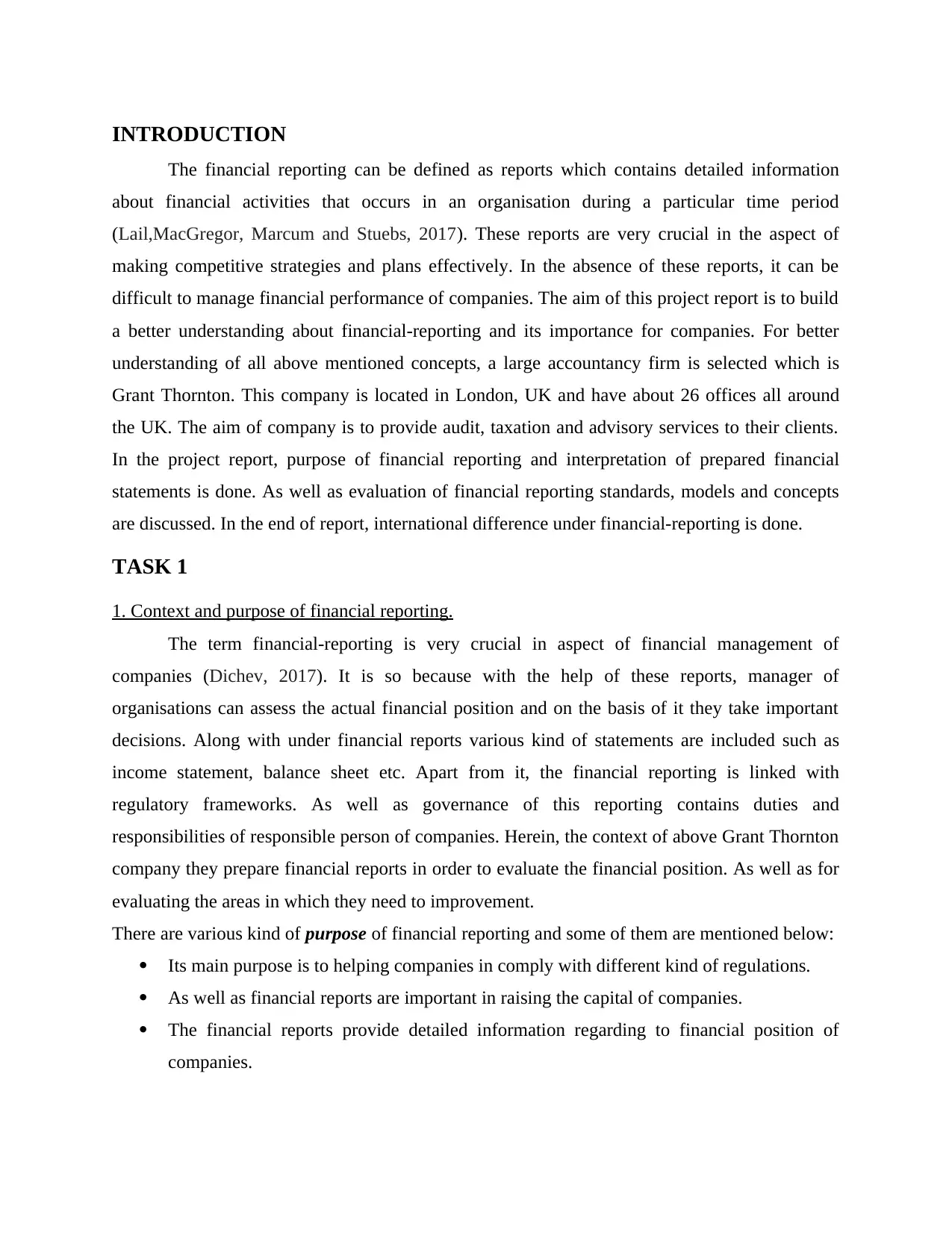
The financial reporting can be defined as reports which contains detailed information
about financial activities that occurs in an organisation during a particular time period
(Lail,MacGregor, Marcum and Stuebs, 2017). These reports are very crucial in the aspect of
making competitive strategies and plans effectively. In the absence of these reports, it can be
difficult to manage financial performance of companies. The aim of this project report is to build
a better understanding about financial-reporting and its importance for companies. For better
understanding of all above mentioned concepts, a large accountancy firm is selected which is
Grant Thornton. This company is located in London, UK and have about 26 offices all around
the UK. The aim of company is to provide audit, taxation and advisory services to their clients.
In the project report, purpose of financial reporting and interpretation of prepared financial
statements is done. As well as evaluation of financial reporting standards, models and concepts
are discussed. In the end of report, international difference under financial-reporting is done.
TASK 1
1. Context and purpose of financial reporting.
The term financial-reporting is very crucial in aspect of financial management of
companies (Dichev, 2017). It is so because with the help of these reports, manager of
organisations can assess the actual financial position and on the basis of it they take important
decisions. Along with under financial reports various kind of statements are included such as
income statement, balance sheet etc. Apart from it, the financial reporting is linked with
regulatory frameworks. As well as governance of this reporting contains duties and
responsibilities of responsible person of companies. Herein, the context of above Grant Thornton
company they prepare financial reports in order to evaluate the financial position. As well as for
evaluating the areas in which they need to improvement.
There are various kind of purpose of financial reporting and some of them are mentioned below:
Its main purpose is to helping companies in comply with different kind of regulations.
As well as financial reports are important in raising the capital of companies.
The financial reports provide detailed information regarding to financial position of
companies.
⊘ This is a preview!⊘
Do you want full access?
Subscribe today to unlock all pages.

Trusted by 1+ million students worldwide
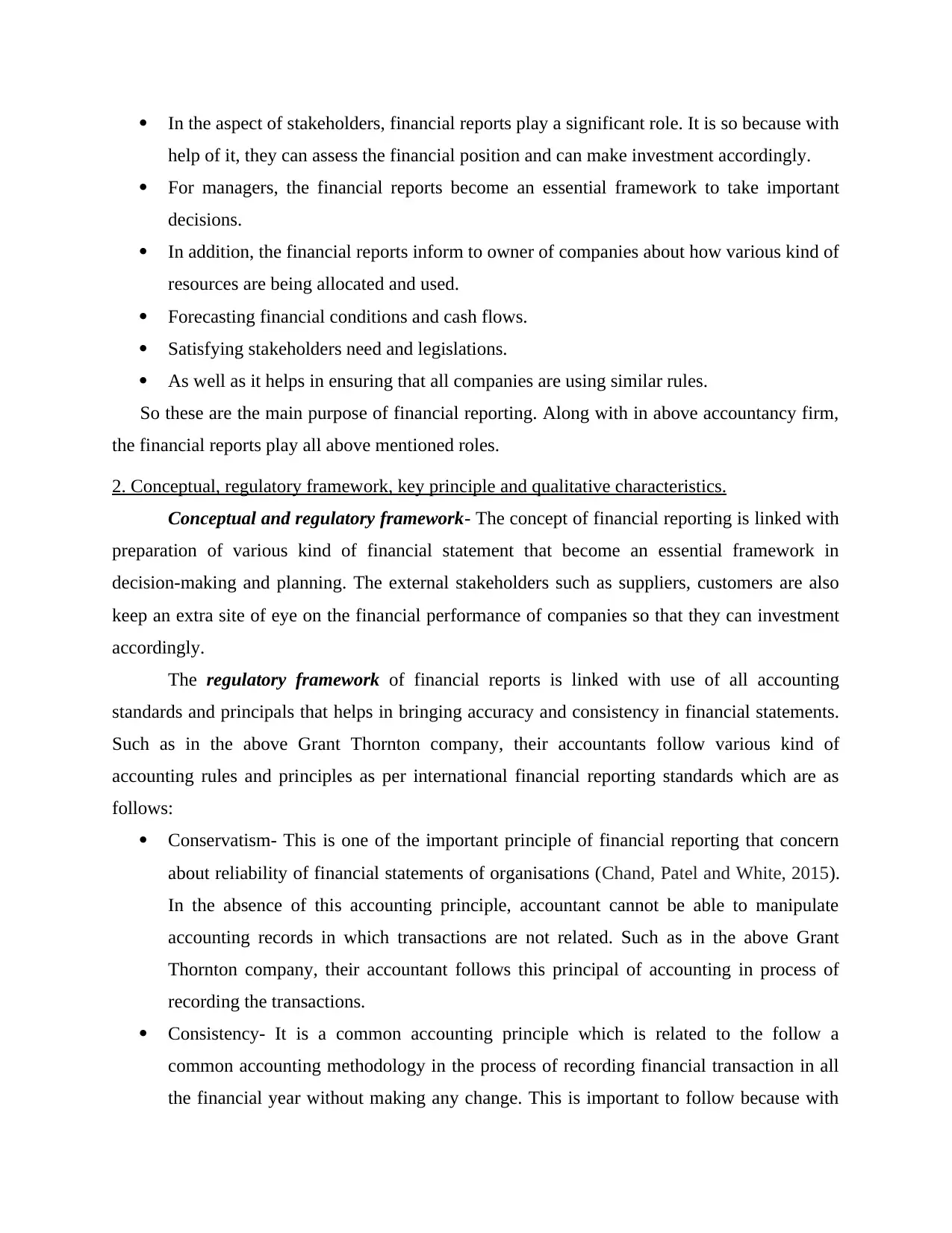
help of it, they can assess the financial position and can make investment accordingly.
For managers, the financial reports become an essential framework to take important
decisions.
In addition, the financial reports inform to owner of companies about how various kind of
resources are being allocated and used.
Forecasting financial conditions and cash flows.
Satisfying stakeholders need and legislations.
As well as it helps in ensuring that all companies are using similar rules.
So these are the main purpose of financial reporting. Along with in above accountancy firm,
the financial reports play all above mentioned roles.
2. Conceptual, regulatory framework, key principle and qualitative characteristics.
Conceptual and regulatory framework- The concept of financial reporting is linked with
preparation of various kind of financial statement that become an essential framework in
decision-making and planning. The external stakeholders such as suppliers, customers are also
keep an extra site of eye on the financial performance of companies so that they can investment
accordingly.
The regulatory framework of financial reports is linked with use of all accounting
standards and principals that helps in bringing accuracy and consistency in financial statements.
Such as in the above Grant Thornton company, their accountants follow various kind of
accounting rules and principles as per international financial reporting standards which are as
follows:
Conservatism- This is one of the important principle of financial reporting that concern
about reliability of financial statements of organisations (Chand, Patel and White, 2015).
In the absence of this accounting principle, accountant cannot be able to manipulate
accounting records in which transactions are not related. Such as in the above Grant
Thornton company, their accountant follows this principal of accounting in process of
recording the transactions.
Consistency- It is a common accounting principle which is related to the follow a
common accounting methodology in the process of recording financial transaction in all
the financial year without making any change. This is important to follow because with
Paraphrase This Document
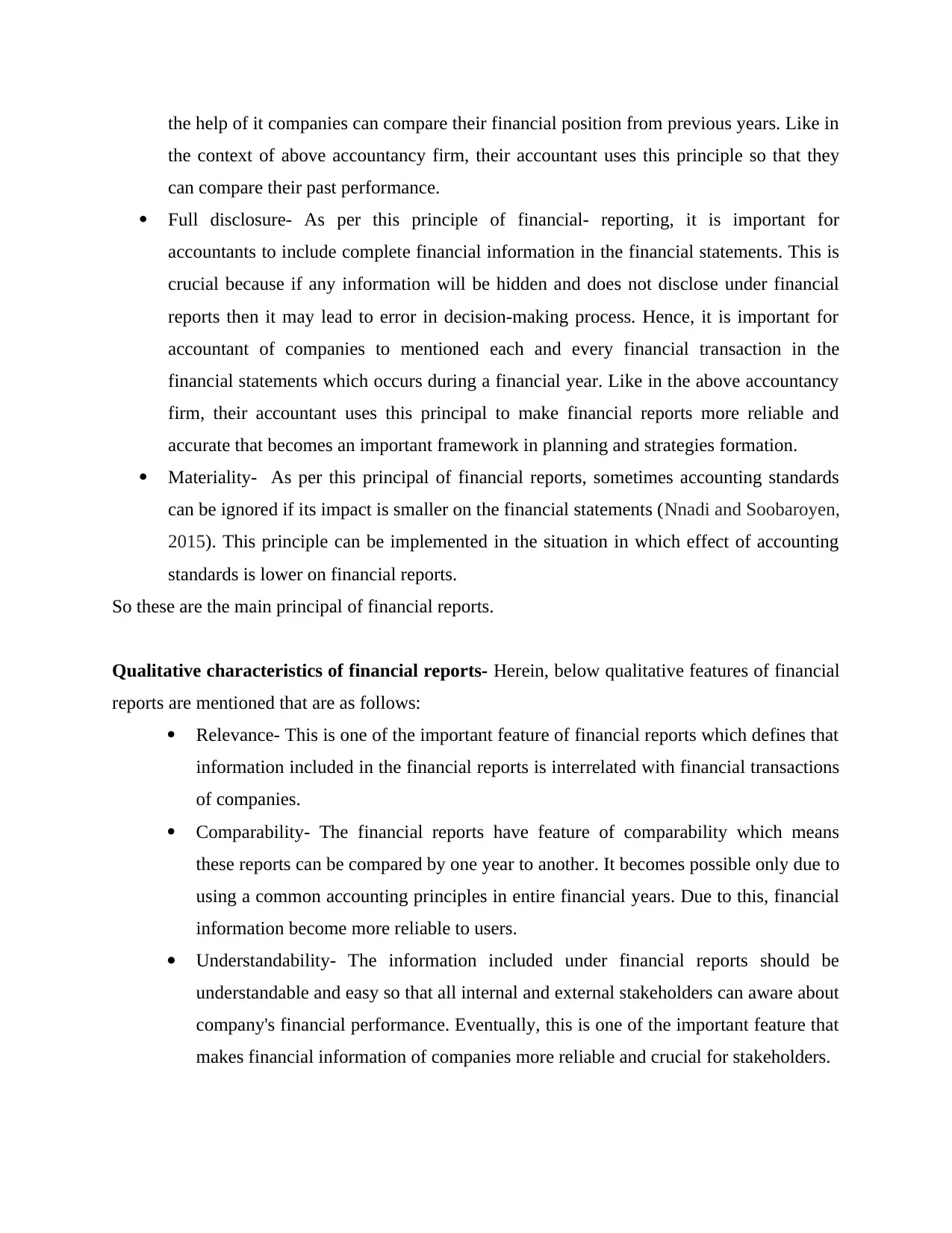
the context of above accountancy firm, their accountant uses this principle so that they
can compare their past performance.
Full disclosure- As per this principle of financial- reporting, it is important for
accountants to include complete financial information in the financial statements. This is
crucial because if any information will be hidden and does not disclose under financial
reports then it may lead to error in decision-making process. Hence, it is important for
accountant of companies to mentioned each and every financial transaction in the
financial statements which occurs during a financial year. Like in the above accountancy
firm, their accountant uses this principal to make financial reports more reliable and
accurate that becomes an important framework in planning and strategies formation.
Materiality- As per this principal of financial reports, sometimes accounting standards
can be ignored if its impact is smaller on the financial statements (Nnadi and Soobaroyen,
2015). This principle can be implemented in the situation in which effect of accounting
standards is lower on financial reports.
So these are the main principal of financial reports.
Qualitative characteristics of financial reports- Herein, below qualitative features of financial
reports are mentioned that are as follows:
Relevance- This is one of the important feature of financial reports which defines that
information included in the financial reports is interrelated with financial transactions
of companies.
Comparability- The financial reports have feature of comparability which means
these reports can be compared by one year to another. It becomes possible only due to
using a common accounting principles in entire financial years. Due to this, financial
information become more reliable to users.
Understandability- The information included under financial reports should be
understandable and easy so that all internal and external stakeholders can aware about
company's financial performance. Eventually, this is one of the important feature that
makes financial information of companies more reliable and crucial for stakeholders.

The stakeholders can be defined as those who show their interest in financial
performance of companies. Herein, this is important to know that stakeholders can be impacted
by change in organisational plans and policies. All stakeholders of companies not equal because
everyone has various purpose. Such as in the above company, they have various kind of
stakeholders including internal and external. Below both kind of stakeholders are mentioned that
are as follows: Internal stakeholders- These are the stakeholders which are related with the involving
in company's day to day operational activities and in preparation of plans (Wang, Cao,
2018). Some example of these stakeholders are managers, board of director, employees
etc. These all stakeholders are very crucial in the aspect of internal management of
companies because activities and functions are performed by them. Below some types of
internal stakeholders are mentioned that are as follows:
*Managers- These stakeholders are very crucial for companies because they are linked with
the preparation of plans and policies to manage the human and financial resources in an effective
manner. Eventually, an organisation's success depends on managers that how they manage their
subordinates. The managers get benefit of financial information for preparation of various kind
of strategies because on the basis of financial position of company they prepare plans. Such as in
the above Grant Thornton company, their managers make futuristic plans and policies on the
basis of their company's financial performance and it is informed by help of financial reports.
* Employees- The employees are kind of internal stakeholders who are related with
completing organisational activities and tasks in which entity operates. These stakeholders are
very important for companies because if employees do not perform very well then this may lead
to inefficiency in task performing. The employees get benefit from financial information to
manage their individual performance. This is so because with the help of analysis of financial
performance of company they can assess their contribution in overall performance. Like in the
above Grant Thornton company, their employees check the financial information of various
activities to determine whether they should continue their job or not. External stakeholders- The external stakeholders are those who continuously evaluate
the financial position of companies to take decision regarding to investment (Cohen and
Karatzimas, 2015). These stakeholders do not effect with the change in companies' plans
⊘ This is a preview!⊘
Do you want full access?
Subscribe today to unlock all pages.

Trusted by 1+ million students worldwide
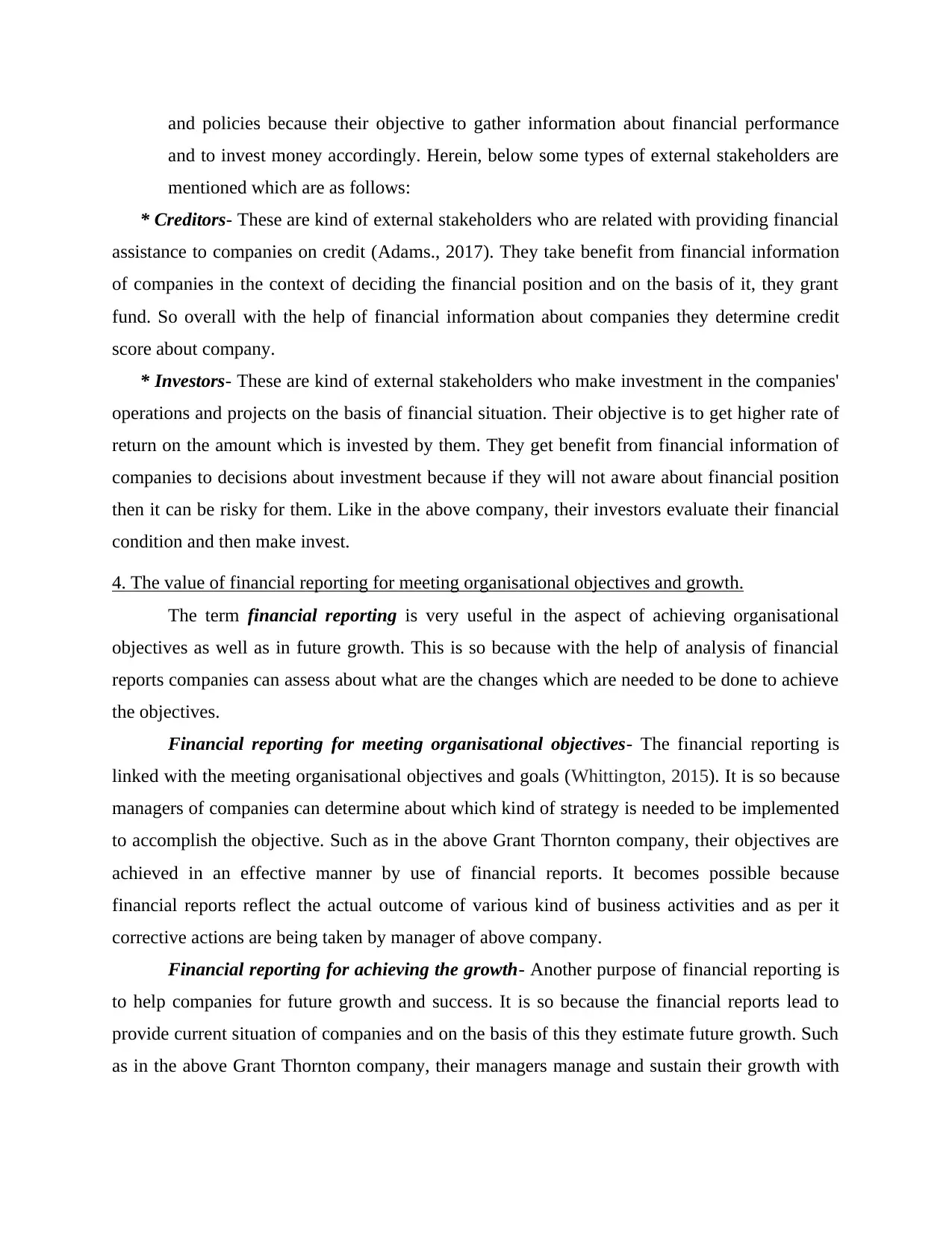
and to invest money accordingly. Herein, below some types of external stakeholders are
mentioned which are as follows:
* Creditors- These are kind of external stakeholders who are related with providing financial
assistance to companies on credit (Adams., 2017). They take benefit from financial information
of companies in the context of deciding the financial position and on the basis of it, they grant
fund. So overall with the help of financial information about companies they determine credit
score about company.
* Investors- These are kind of external stakeholders who make investment in the companies'
operations and projects on the basis of financial situation. Their objective is to get higher rate of
return on the amount which is invested by them. They get benefit from financial information of
companies to decisions about investment because if they will not aware about financial position
then it can be risky for them. Like in the above company, their investors evaluate their financial
condition and then make invest.
4. The value of financial reporting for meeting organisational objectives and growth.
The term financial reporting is very useful in the aspect of achieving organisational
objectives as well as in future growth. This is so because with the help of analysis of financial
reports companies can assess about what are the changes which are needed to be done to achieve
the objectives.
Financial reporting for meeting organisational objectives- The financial reporting is
linked with the meeting organisational objectives and goals (Whittington, 2015). It is so because
managers of companies can determine about which kind of strategy is needed to be implemented
to accomplish the objective. Such as in the above Grant Thornton company, their objectives are
achieved in an effective manner by use of financial reports. It becomes possible because
financial reports reflect the actual outcome of various kind of business activities and as per it
corrective actions are being taken by manager of above company.
Financial reporting for achieving the growth- Another purpose of financial reporting is
to help companies for future growth and success. It is so because the financial reports lead to
provide current situation of companies and on the basis of this they estimate future growth. Such
as in the above Grant Thornton company, their managers manage and sustain their growth with
Paraphrase This Document

growth of companies.
TASK 2.
5. Preparation of main financial statements on the basis of given information.
a) Profit and Loss statement
31.12.18
(£'000)
Continuing operations
Particulars Amount
Revenue from Operations (A) 585100
Cost of goods sold (391700)
Cost of providing services -
Gross profit 193400
Less: Operating expenses 80500
Less: Depreciation (W.N. 1) 26715
Less: Other Income (9600)
Operating profit 95785
Less: Bank interest 1200
Profit before exceptional items and tax 94585
Exceptional Items Nil
Profit before tax 94585
Less: Income tax expense 9500
Profit after tax 85085
Add: Other Comprehensive income -
Total Comprehensive income 85085
Working Note:
Calculation of depreciation expenses:
Land and machinery: 150000/16 = £9375
Plant and equipment: 148000-32400 = £115600
115600*15/100 = £17340
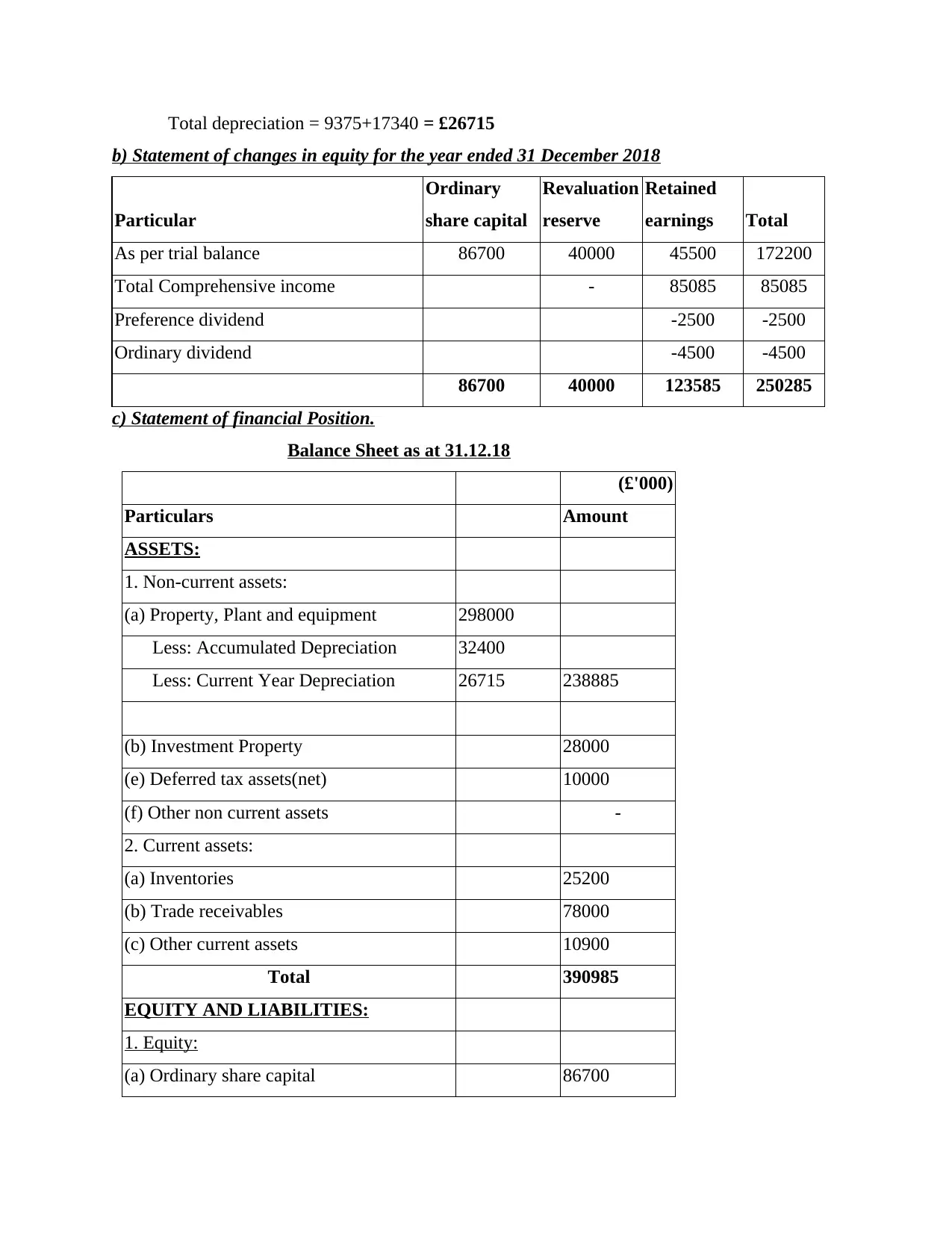
b) Statement of changes in equity for the year ended 31 December 2018
Particular
Ordinary
share capital
Revaluation
reserve
Retained
earnings Total
As per trial balance 86700 40000 45500 172200
Total Comprehensive income - 85085 85085
Preference dividend -2500 -2500
Ordinary dividend -4500 -4500
86700 40000 123585 250285
c) Statement of financial Position.
Balance Sheet as at 31.12.18
(£'000)
Particulars Amount
ASSETS:
1. Non-current assets:
(a) Property, Plant and equipment 298000
Less: Accumulated Depreciation 32400
Less: Current Year Depreciation 26715 238885
(b) Investment Property 28000
(e) Deferred tax assets(net) 10000
(f) Other non current assets -
2. Current assets:
(a) Inventories 25200
(b) Trade receivables 78000
(c) Other current assets 10900
Total 390985
EQUITY AND LIABILITIES:
1. Equity:
(a) Ordinary share capital 86700
⊘ This is a preview!⊘
Do you want full access?
Subscribe today to unlock all pages.

Trusted by 1+ million students worldwide
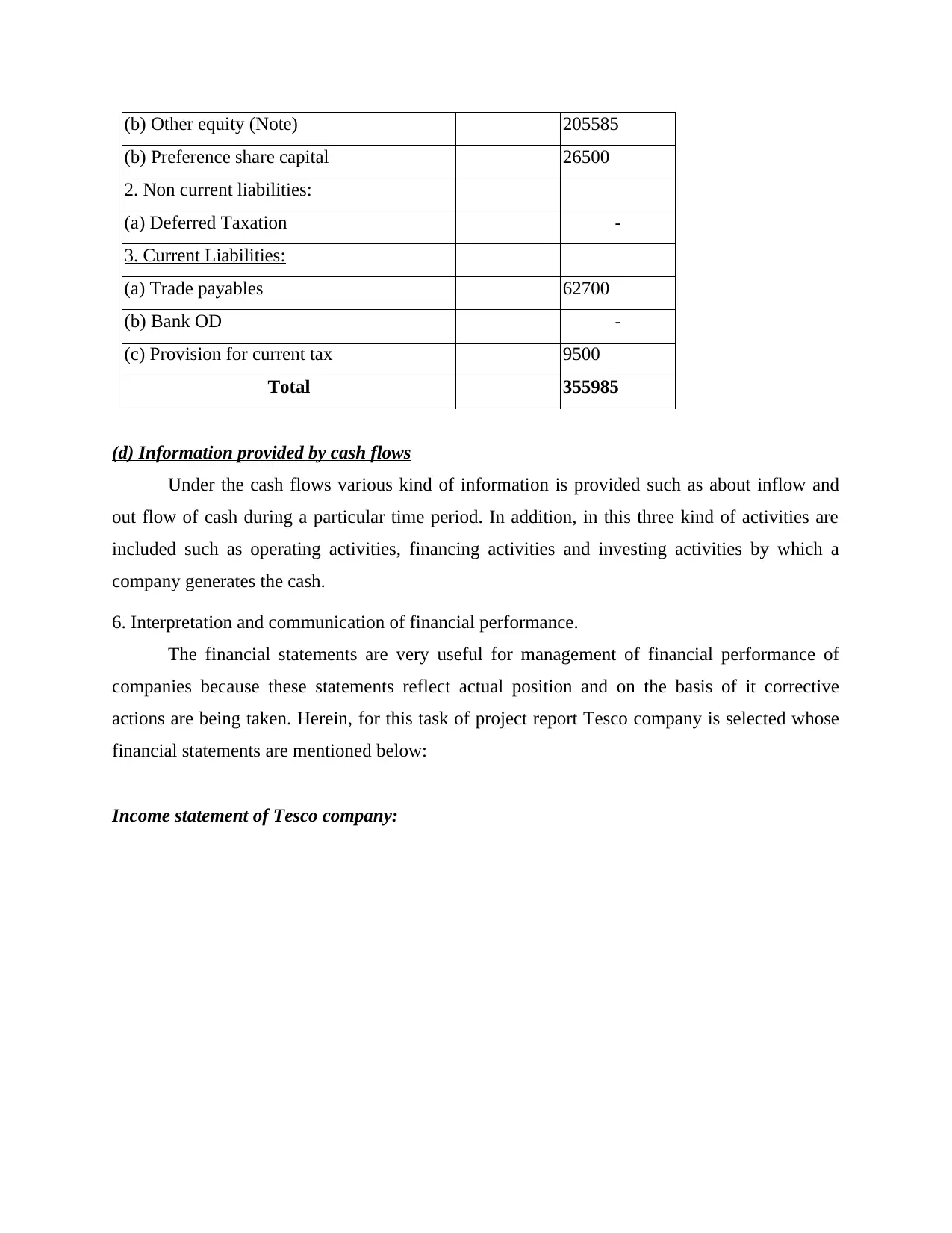
(b) Preference share capital 26500
2. Non current liabilities:
(a) Deferred Taxation -
3. Current Liabilities:
(a) Trade payables 62700
(b) Bank OD -
(c) Provision for current tax 9500
Total 355985
(d) Information provided by cash flows
Under the cash flows various kind of information is provided such as about inflow and
out flow of cash during a particular time period. In addition, in this three kind of activities are
included such as operating activities, financing activities and investing activities by which a
company generates the cash.
6. Interpretation and communication of financial performance.
The financial statements are very useful for management of financial performance of
companies because these statements reflect actual position and on the basis of it corrective
actions are being taken. Herein, for this task of project report Tesco company is selected whose
financial statements are mentioned below:
Income statement of Tesco company:
Paraphrase This Document
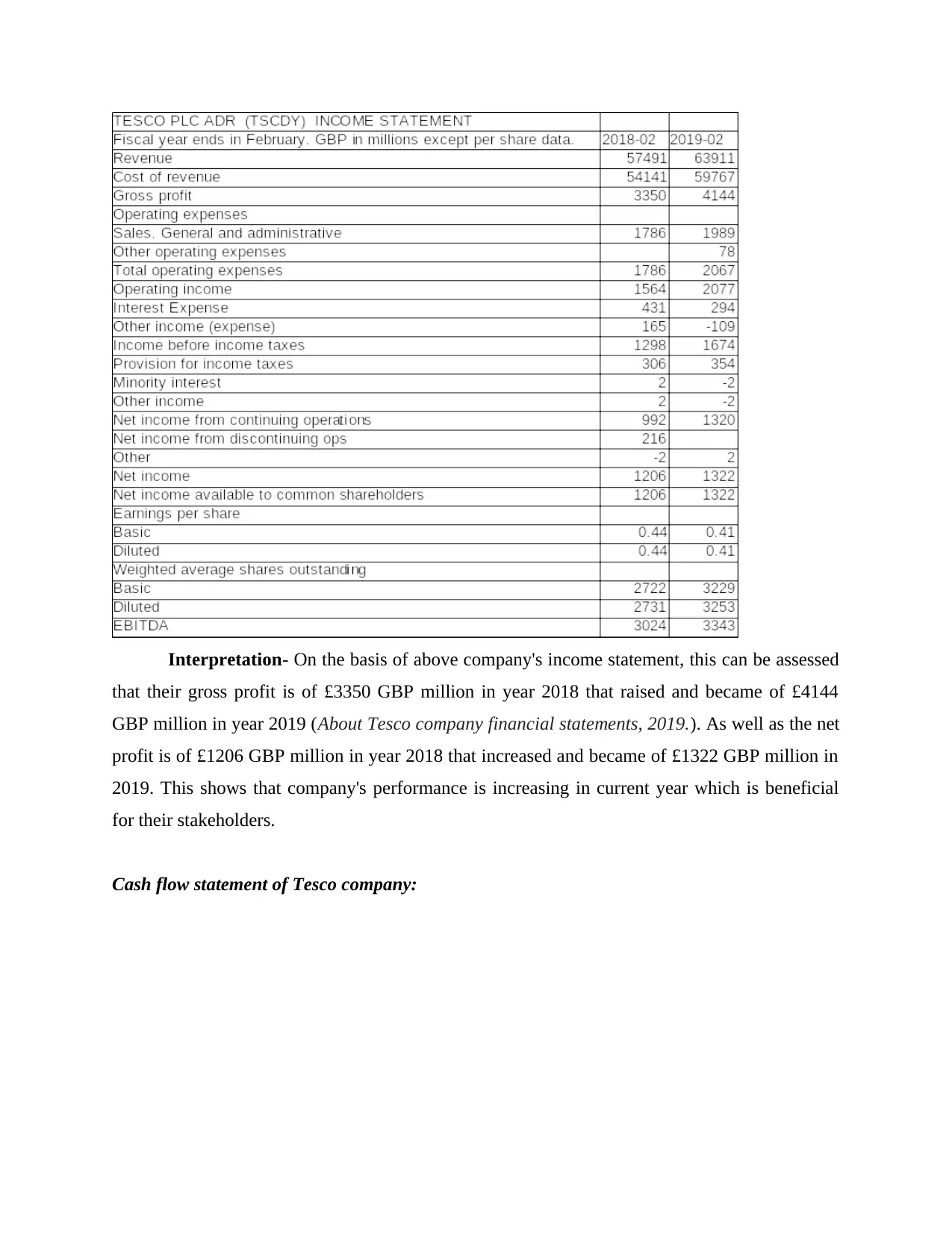
that their gross profit is of £3350 GBP million in year 2018 that raised and became of £4144
GBP million in year 2019 (About Tesco company financial statements, 2019.). As well as the net
profit is of £1206 GBP million in year 2018 that increased and became of £1322 GBP million in
2019. This shows that company's performance is increasing in current year which is beneficial
for their stakeholders.
Cash flow statement of Tesco company:
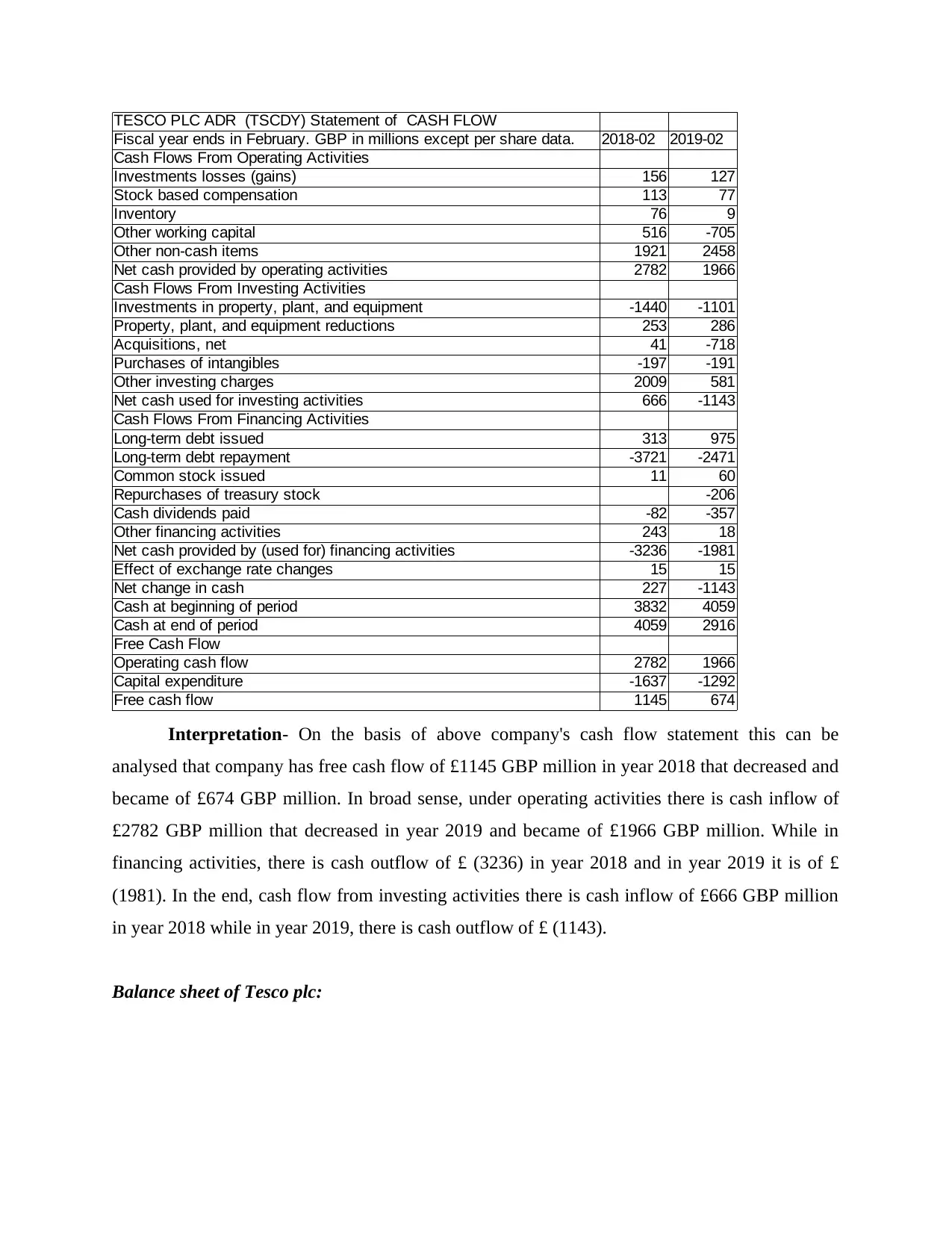
Fiscal year ends in February. GBP in millions except per share data. 2018-02 2019-02
Cash Flows From Operating Activities
Investments losses (gains) 156 127
Stock based compensation 113 77
Inventory 76 9
Other working capital 516 -705
Other non-cash items 1921 2458
Net cash provided by operating activities 2782 1966
Cash Flows From Investing Activities
Investments in property, plant, and equipment -1440 -1101
Property, plant, and equipment reductions 253 286
Acquisitions, net 41 -718
Purchases of intangibles -197 -191
Other investing charges 2009 581
Net cash used for investing activities 666 -1143
Cash Flows From Financing Activities
Long-term debt issued 313 975
Long-term debt repayment -3721 -2471
Common stock issued 11 60
Repurchases of treasury stock -206
Cash dividends paid -82 -357
Other financing activities 243 18
Net cash provided by (used for) financing activities -3236 -1981
Effect of exchange rate changes 15 15
Net change in cash 227 -1143
Cash at beginning of period 3832 4059
Cash at end of period 4059 2916
Free Cash Flow
Operating cash flow 2782 1966
Capital expenditure -1637 -1292
Free cash flow 1145 674
Interpretation- On the basis of above company's cash flow statement this can be
analysed that company has free cash flow of £1145 GBP million in year 2018 that decreased and
became of £674 GBP million. In broad sense, under operating activities there is cash inflow of
£2782 GBP million that decreased in year 2019 and became of £1966 GBP million. While in
financing activities, there is cash outflow of £ (3236) in year 2018 and in year 2019 it is of £
(1981). In the end, cash flow from investing activities there is cash inflow of £666 GBP million
in year 2018 while in year 2019, there is cash outflow of £ (1143).
Balance sheet of Tesco plc:
⊘ This is a preview!⊘
Do you want full access?
Subscribe today to unlock all pages.

Trusted by 1+ million students worldwide
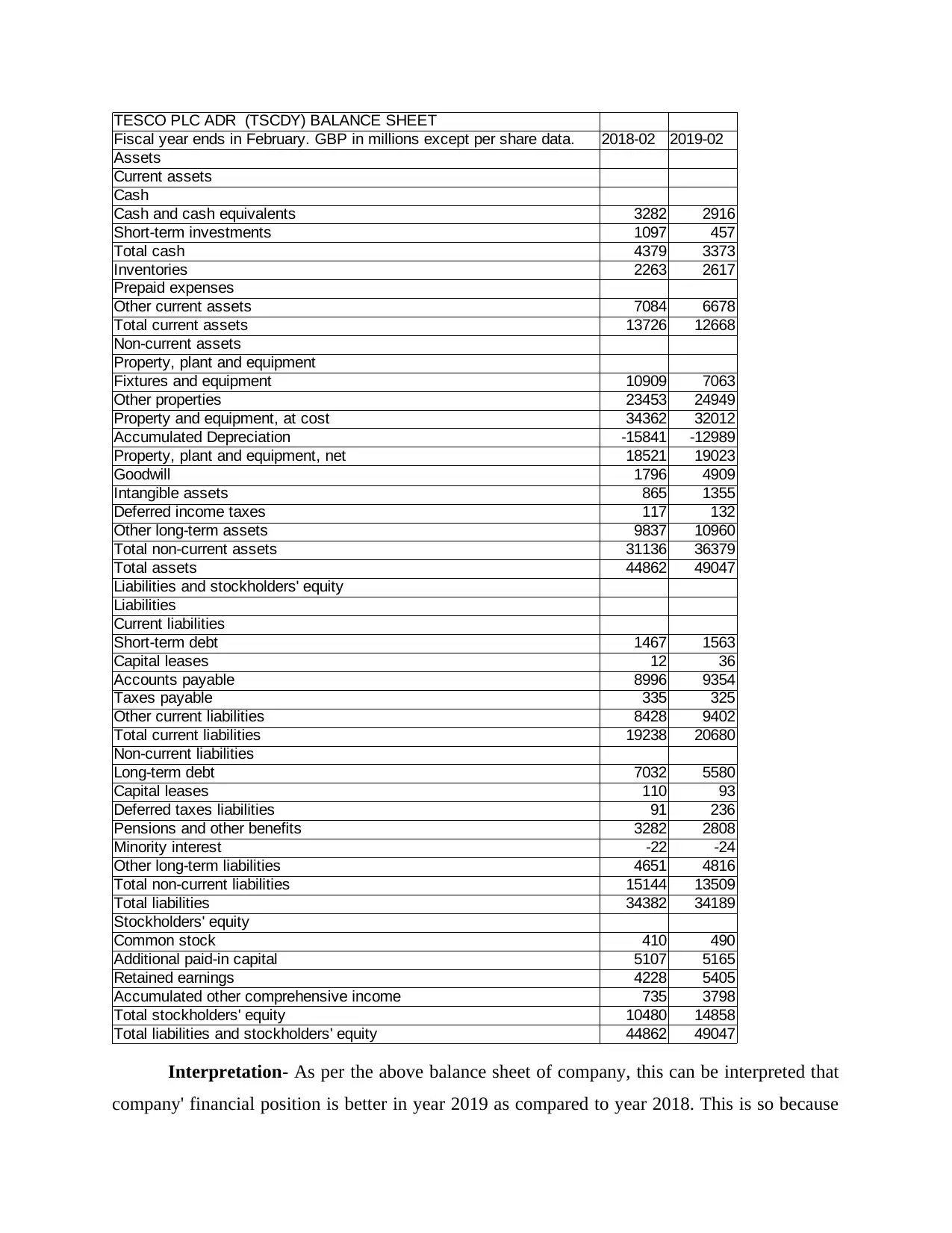
Fiscal year ends in February. GBP in millions except per share data. 2018-02 2019-02
Assets
Current assets
Cash
Cash and cash equivalents 3282 2916
Short-term investments 1097 457
Total cash 4379 3373
Inventories 2263 2617
Prepaid expenses
Other current assets 7084 6678
Total current assets 13726 12668
Non-current assets
Property, plant and equipment
Fixtures and equipment 10909 7063
Other properties 23453 24949
Property and equipment, at cost 34362 32012
Accumulated Depreciation -15841 -12989
Property, plant and equipment, net 18521 19023
Goodwill 1796 4909
Intangible assets 865 1355
Deferred income taxes 117 132
Other long-term assets 9837 10960
Total non-current assets 31136 36379
Total assets 44862 49047
Liabilities and stockholders' equity
Liabilities
Current liabilities
Short-term debt 1467 1563
Capital leases 12 36
Accounts payable 8996 9354
Taxes payable 335 325
Other current liabilities 8428 9402
Total current liabilities 19238 20680
Non-current liabilities
Long-term debt 7032 5580
Capital leases 110 93
Deferred taxes liabilities 91 236
Pensions and other benefits 3282 2808
Minority interest -22 -24
Other long-term liabilities 4651 4816
Total non-current liabilities 15144 13509
Total liabilities 34382 34189
Stockholders' equity
Common stock 410 490
Additional paid-in capital 5107 5165
Retained earnings 4228 5405
Accumulated other comprehensive income 735 3798
Total stockholders' equity 10480 14858
Total liabilities and stockholders' equity 44862 49047
Interpretation- As per the above balance sheet of company, this can be interpreted that
company' financial position is better in year 2019 as compared to year 2018. This is so because
Paraphrase This Document
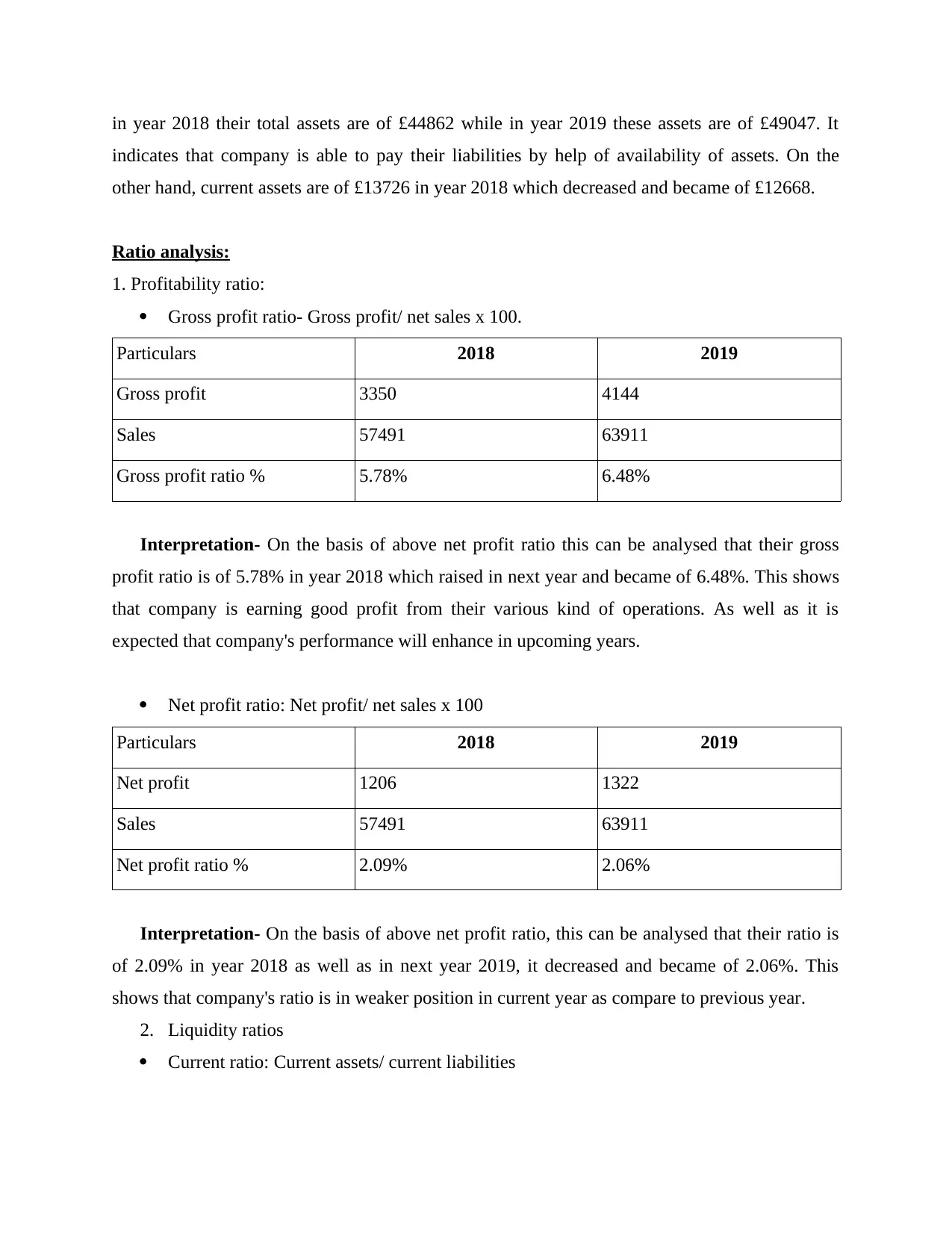
indicates that company is able to pay their liabilities by help of availability of assets. On the
other hand, current assets are of £13726 in year 2018 which decreased and became of £12668.
Ratio analysis:
1. Profitability ratio:
Gross profit ratio- Gross profit/ net sales x 100.
Particulars 2018 2019
Gross profit 3350 4144
Sales 57491 63911
Gross profit ratio % 5.78% 6.48%
Interpretation- On the basis of above net profit ratio this can be analysed that their gross
profit ratio is of 5.78% in year 2018 which raised in next year and became of 6.48%. This shows
that company is earning good profit from their various kind of operations. As well as it is
expected that company's performance will enhance in upcoming years.
Net profit ratio: Net profit/ net sales x 100
Particulars 2018 2019
Net profit 1206 1322
Sales 57491 63911
Net profit ratio % 2.09% 2.06%
Interpretation- On the basis of above net profit ratio, this can be analysed that their ratio is
of 2.09% in year 2018 as well as in next year 2019, it decreased and became of 2.06%. This
shows that company's ratio is in weaker position in current year as compare to previous year.
2. Liquidity ratios
Current ratio: Current assets/ current liabilities

Current assets 13726 12668
Current liabilities 19238 20680
Current ratio 0.71% 0.61%
Interpretation- As per the above current ratio of above company, this can be said that ratio
is of 0.71 times in year 2018 that decreased and became of 0.61. It indicates that company's
liquidity position is weaker in both the years. This is so because the ideal current ratio is of 2:1
which means a company should have double assets for payment of one times of liabilities. While
this company's current ratio is below of ideal ratio that is needed to improve.
Quick ratio: Quick assets / current liabilities
Particulars 2018 2019
Quick assets 11463 10051
Current liabilities 19238 20680
Quick ratio 0.59% 0.48%
Interpretation- Same as the current ratio, the quick ratio is also deceasing in year 2019
in compare to year 2018. Like in year 2018, the quick ratio is of 0.59 times that decreased in next
year and became of 0.48 times in year 2019. Apart from it, their quick ratio is no ideal condition
because ideal ratio is of 1.5: 1 and this company's ratio is not matching with ideal standard.
Hence, it can be interpreted that above company's liquidity position is weak to pay day to day
short term debts which in both of years
TASK 3.
7. The difference between international Accounting Standards (lAS) and if international
Financial Reporting Standards (IFRS).
IAS (International accounting standard)- The international accounting standards are those
which defines about the way to prepare and present the financial statements (Hope and Vyas,
⊘ This is a preview!⊘
Do you want full access?
Subscribe today to unlock all pages.

Trusted by 1+ million students worldwide

standard and committee (IASC).
International Financial Reporting Standards (IFRS): These are kind of standards which
are being applied to check and compute outcome of companies in terms of profit. The standards
are accepted worldwide by all companies.
Difference between IAS and IFRS:
IAS IFRS
The IAS stands for international accounting
standard.
While IFRS stands for international financial-
reporting standard.
The international accounting standards were
published by IASC.
While the IFRS were published by
international accounting standard board.
The IAS were published during year 1973 and
2001 (Richards and van Staden, 2015).
On the other hand, these standards were
established in year 2001.
8. Advantage of International financial reporting system.
The international reporting system is crucial for companies, this is so because with the
help of these international standard of reports provide a common format to prepare financial
statements (Durnev and Magnan, 2017). If companies produce their financial reports on the basis
of international standards, then it becomes easy to compare financial performance at global level.
As well as due to this companies can be able to prepare their financial statements more
transparent, accountable and understandable. Apart from above mentioned benefits, the
international financial reporting system is beneficial for economic development of countries.
This is so because with the help of common accounting standards for preparation of financial
reports, investors make investment across the border. It becomes possible only because of
financial reporting standards.
Apart from the investors, stakeholders also get benefit by the information provided by
financial reporting by help of international reporting standards. Herein, below benefits of
international financial reporting standard are mentioned that are as follows:
With the use of international financial-reporting standards companies can keep their cost
of capital under control. This is so because with the use of these standards, additional cost
such as consultancy charges, accountants can be minimised.
Paraphrase This Document
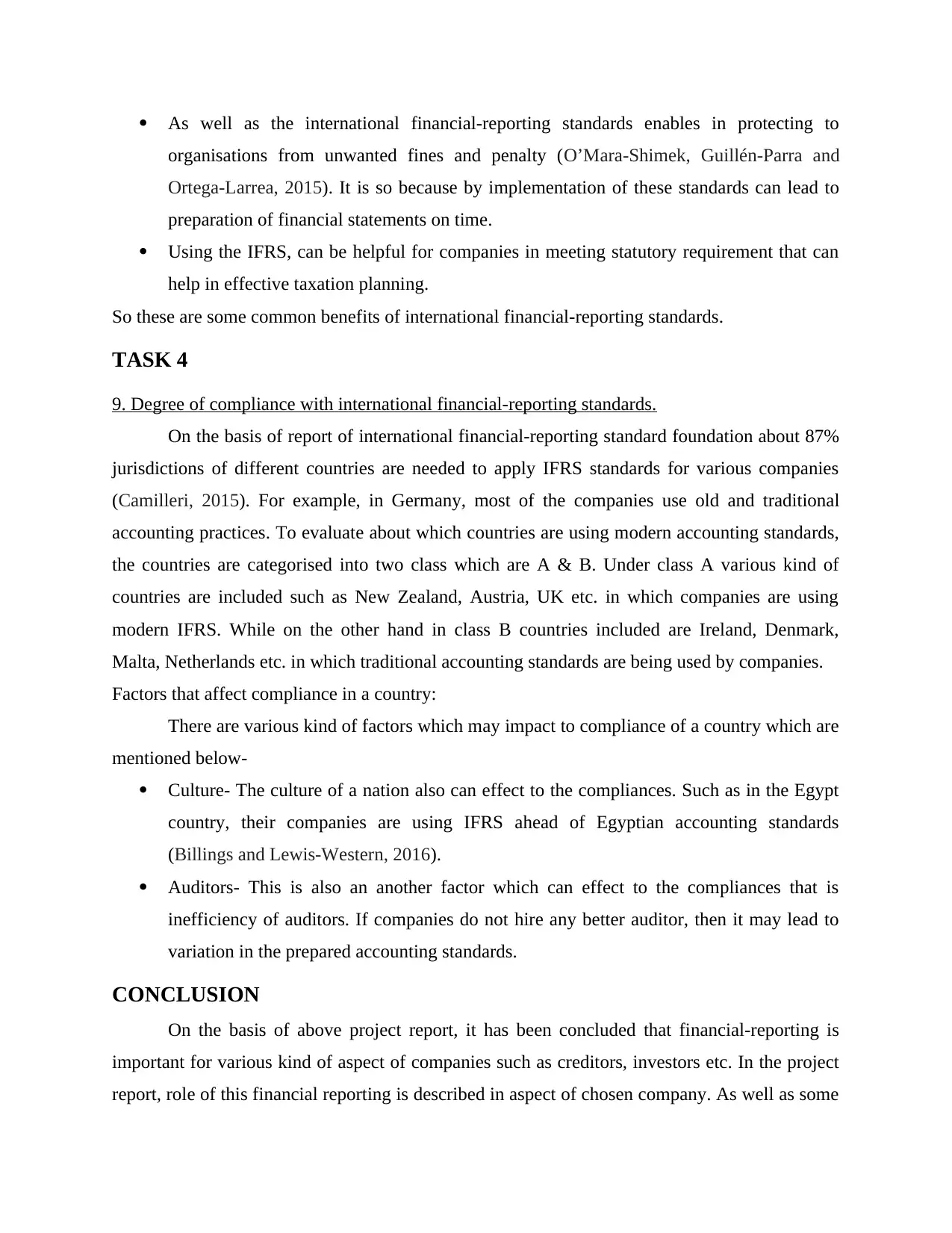
organisations from unwanted fines and penalty (O’Mara-Shimek, Guillén-Parra and
Ortega-Larrea, 2015). It is so because by implementation of these standards can lead to
preparation of financial statements on time.
Using the IFRS, can be helpful for companies in meeting statutory requirement that can
help in effective taxation planning.
So these are some common benefits of international financial-reporting standards.
TASK 4
9. Degree of compliance with international financial-reporting standards.
On the basis of report of international financial-reporting standard foundation about 87%
jurisdictions of different countries are needed to apply IFRS standards for various companies
(Camilleri, 2015). For example, in Germany, most of the companies use old and traditional
accounting practices. To evaluate about which countries are using modern accounting standards,
the countries are categorised into two class which are A & B. Under class A various kind of
countries are included such as New Zealand, Austria, UK etc. in which companies are using
modern IFRS. While on the other hand in class B countries included are Ireland, Denmark,
Malta, Netherlands etc. in which traditional accounting standards are being used by companies.
Factors that affect compliance in a country:
There are various kind of factors which may impact to compliance of a country which are
mentioned below-
Culture- The culture of a nation also can effect to the compliances. Such as in the Egypt
country, their companies are using IFRS ahead of Egyptian accounting standards
(Billings and Lewis‐Western, 2016).
Auditors- This is also an another factor which can effect to the compliances that is
inefficiency of auditors. If companies do not hire any better auditor, then it may lead to
variation in the prepared accounting standards.
CONCLUSION
On the basis of above project report, it has been concluded that financial-reporting is
important for various kind of aspect of companies such as creditors, investors etc. In the project
report, role of this financial reporting is described in aspect of chosen company. As well as some

addition, Tesco company' s financial statements are mentioned and interpreted for decision-
making. Apart from it, role of international financial-reporting standards for companies is
described in the end part of project report.
⊘ This is a preview!⊘
Do you want full access?
Subscribe today to unlock all pages.

Trusted by 1+ million students worldwide
Related Documents
Your All-in-One AI-Powered Toolkit for Academic Success.
+13062052269
info@desklib.com
Available 24*7 on WhatsApp / Email
![[object Object]](/_next/static/media/star-bottom.7253800d.svg)
© 2024 | Zucol Services PVT LTD | All rights reserved.





